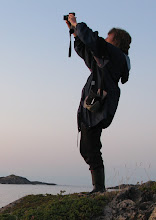The "big, isolated hill" which gives its name to the area looms over Rocky Harbour, the bustling coastal town which was our base for the week.
Gros Morne is also the name of the outstanding national park that encompasses 1800 square kilometres of such scenic beauty and geological complexity that it was named a UNESCO World Heritage Site in 1987. The park offers a wide range of interpretive experiences that really should not be missed. Weather permitting.
Our first attempt was an investigation of life in a tide pool. Sixty-kilometre winds had whipped up lashing waves and the platform we were to have explored was lost below angry waters.
The interpreter made a valiant attempt to give us the introductory talk at the water's edge.
Our second session was on the geology of Green Point a day later. Note the interpreter's dress and be reminded that this is an August day. (She had also been wearing a jacket but had generously loaned it to an underdressed participant.) This delightful young woman began her talk by explaining that if we were a group of geologists, she would have to be urging us to calm down since Green Point marks the division between the Cambrian and Ordovician periods and is considered one of geology's Top Ten.
In this photo, she is using sponges to represent the layers of shale and limestone that were upturned a bezillion years ago. (I stand to be corrected on that number.) An explanation right at my level of understanding!
Who knew that rocks could be so interesting? Ah. . .the geologist, represented here along with a scientist from another discipline.
These wonderful characters are housed in the Visitors Centre in Woody Point. This place has to be one of the best uses of taxpayers' money ever.
The centre also has a fine art gallery which included this painting of the tablelands. Below is my photograph of the same area. The painting is closer to reality - at least when the sun shines.
10 seagulls sitting on a roof. One flew away and then there were 9. Hey, I think I've got the makings of a kids' book here!
Norris Point photo ops.









































